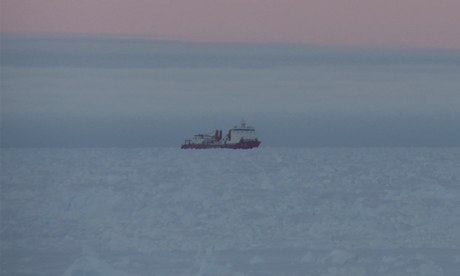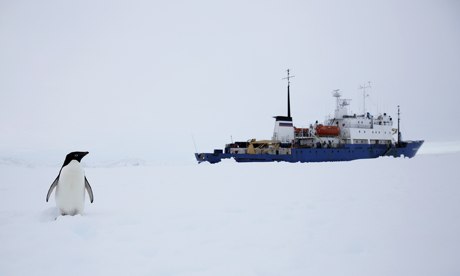
A Chinese icebreaker ship is making its way through dense pack-ice just off the coast of Cape de la Motte in Antarctica, where a ship of scientists and members of the public have been trapped since Christmas Day.
The vessel, the Xue Long, and a French icebreaker, the Astrolabe, reached the edge of the ice pack, around 13 nautical miles from the Russian-operated MV Akademik Shokalskiy, just before 7pm New Zealand time (6am GMT) on Friday.
The Xue Long started cutting through the ice soon after, and has made steady, but slow, progress since and is now within sight of the stricken vessel. The ice it has encountered at the edge has been much thicker than expected - 3-4 metres thick in some places. It is travelling at between 0.1 to 3 knots depending on the density of the ice and should reach the Shokalskiy some time in the next 12 hours. The Astrolabe has not yet entered the ice field.
"We know that the ice conditions around us are extremely difficult and that the ice is under a lot of pressure," said Greg Mortimer, co-leader of the Australasian Antarctic Expedition (AAE), aboard the Shokalskiy. "The ships that are coming to assist us will probably not have the ability to cut a path into us individually, so they have to work in tandem."
When the icebreaker gets close to the Shokalskiy, it will cut a ring in the ice around the Russian ship so that the latter can manoeuvre itself into the a newly opened channel behind the Xue Long. "It's quite an elaborate operation and one that takes some time," Mortimer said.
The Shokalskiy will then follow close behind the Chinese vessel as it carves another channel through the ice and heads back to the open waters of the Southern Ocean.

"The nature of Antarctica is very different to the rest of the world - everything is at a bigger scale," said Chris Fogwill, a glaciologist at the University of New South Wales and a co-leader of the AAE. "Storms are ever-present, the rate at which they shift is very unpredictable because there is so much ocean around. At the edge of the continent you have strong weather systems and the speed at which things can happen is astronomical, it's so far outside out normal frame of reference."
The Shokalskiy became stuck just over two weeks into its month-long journey from Bluff, in New Zealand, to Commonwealth Bay, in East Antarctica. It is now at Cape de la Motte, around 1,500 nautical miles from Hobart, in Tasmania. On board are 48 passengers - half of them scientists, the other half paying members of the public who are assisting in the experiments - and 20 crew members, following in the footsteps of the great Antarctic explorer and scientist Douglas Mawson, leader of the original AAE of 1911.
The ship has been sailing through the Southern Ocean since 8 December, repeating and extending many of Mawson's wildlife, ocean and weather observations in order to build a picture of how this part of the world has changed in 100 years.
The expedition had already reached the fast ice off Commonwealth Bay, carrying out measurements of the Southern Ocean along the way. A small team of scientists and conservationists also reached the iconic Mawson's Huts at Cape Denison last week, 40 miles across the ice from where the ship was anchored. The expedition was heading east on Tuesday, to spend a day at the Mertz glacier, when it became trapped among thick ice floes stacked up by bad weather near Stillwell Island, off the cape.
"The prevailing wind after we arrived built up into a very strong south-easterly and that pushed the ice into our path, preventing our exit into the clear water outside," Fogwill said. A strong westerly wind would blow the pack ice out of the Shokalskiy's way within a day, he said, but such a weather system was not predicted to occur anytime soon, given prevailing conditions.
The Xue Long, which translates as Snow Dragon, was already on its way to help construct the new Chinese Antarctic base near the Ross Sea when it was asked to detour and assist the Shokalskiy. The Astrolabe has been sent from Dumont D'Urville, the nearest Antarctic base to Cape de la Motte. Also on its way to the Shokalskiy, but still a few days' sailing time away, is the Australian icebreaker, Aurora Australis.
"The Chinese are on a really tight timeframe because they're building their new base and there is a short Antarctic summer season," Fogwill said. "Still, there's been no hesitation to come and help us - we're very grateful and it's a big gesture."



Reader Comments
to our Newsletter